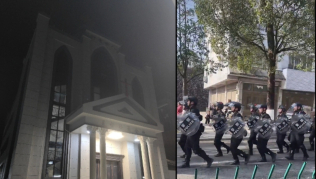WASHINGTON - The nation honored Gerald R. Ford on Tuesday under towering cathedral arches, a high-powered fanfare for the common man who was summoned to the presidency in the crisis that drove his predecessor from office.
"In President Ford, the world saw the best of America and America found a man whose character and leadership would bring calm and healing to one of the most divisive moments in our nation's history," President Bush said in his prepared eulogy.
The elaborate invitation-only service at the Washington National Cathedral was the final assembly in the capital's portion of the state funeral for the 38th president, before Ford's interment Wednesday in Grand Rapids, Mich.
The elder President Bush, opening the eulogies, called Ford a "Norman Rockwell painting come to life" and pierced the solemnity of the occasion by cracking gentle jokes about Ford's reputation as an errant golfer. Former President Clinton and Vice President Dick Cheney joined in the laughter.
Henry Kissinger, Ford's secretary of state, paid tribute to Ford's leadership in achieving nuclear arms control with the Soviets, in the first political agreement between Israel and Egypt and in helping to bring majority rule to southern Africa, among other achievements often overlooked in the modest man.
"In his understated way he did his duty as a leader, not as a performer playing to the gallery," Kissinger said. "Gerald Ford had the virtues of small town America."
The crisp steps of the military pallbearers echoed through the cavernous space as Ford's remains came to a church he had visited at least seven times as vice president, president or ex-president. Supreme Court justices occupied a front row.
On a national day of mourning that closed most of the government as well as financial markets, the cortege brought his casket to the cathedral in blustery winds that blew off the hats of the chairman of the Joint Chiefs of Staff, Gen. Peter Pace, and members of the honor guard outside the service. White-gloved police officers lined the route passing the White House to the cathedral; light, subdued crowds watched the cortege.
Inside, more than 3,000 people, including the three living ex-presidents, mourned the man who was charged with restoring trust in government after Richard Nixon's downfall. They remembered an unassuming leader who was content with his congressional career until history called him to higher office.
"When President Nixon needed to replace a vice president who had resigned in scandal, he naturally turned to a man whose name was a synonym for integrity," Bush said in his remarks. "And eight months later, when he was elevated to the presidency, it was because America needed him, not because he needed the office."
He escorted Ford's widow, Betty, down and the aisle of the great stone cathedral, which stretches nearly the length of two football fields and has soaring towers, 215 stained glass windows and an organ with 10,650 pipes.
The three living ex-presidents, Clinton, the elder Bush and Jimmy Carter, who defeated Ford in 1976, all attended.
Thousands of average Americans filed into the Capitol Rotunda over two days and a night to pay final respects to Ford.
Afterward, Ford's remains briefly lay in repose outside the Senate chamber in tribute to his tenure as Senate president when he served as Nixon's vice president. Similarly, his casket had rested outside the House chamber upon its arrival Saturday in remembrance of his quarter century as a Michigan congressman.
The thunder of cannon heralded Ford's departure from the Capitol, a military honor guard carrying his casket down the steps as Mrs. Ford watched and his honorary pallbearers stood with hands over their hearts.
Along with Bush, former Secretary of State Henry Kissinger and NBC newsman Tom Brokaw were eulogists at the cathedral. Funeral services were held there for former presidents Eisenhower in 1969 and Reagan in 2004, and ex-President Wilson is buried there.
Outside the Senate chamber earlier, the historic Ohio Clock Corridor was alive with symbolism around the casket. Ford's vice presidential bust had been moved at the family's request from around the corner to the door of the chamber for the occasion, gazing over the casket.
Ford's children and half brother, Jack, paused in their prayers to glance briefly from the bust to the casket.
Off to their right stood a reminder of how Ford rose to his place in history. Set back in a niche stood a bust of Nixon, the head turned toward the casket.
Ford died at 93 on Dec. 26 at his home in Rancho Mirage, Calif.
The national funeral service capped Washington's portion of a state funeral that began in Palm Desert, Calif., in a church where the Fords worshipped in his retirement, and concludes with a final public visitation in Grand Rapids, a private service, and interment on a hillside overlooking his museum.
Ford was appointed vice president by Nixon to replace Spiro Agnew, who resigned in a bribery scandal stemming from his days as Maryland governor. After Nixon resigned, Ford assumed the presidency for 2 1/2 years.
A month after taking office, Ford pardoned Nixon for any Watergate crimes he might have committed.
AP writers Laurie Kellman, Larry Margasak, Natasha Metzler and Kasie Hunt contributed to this story.







